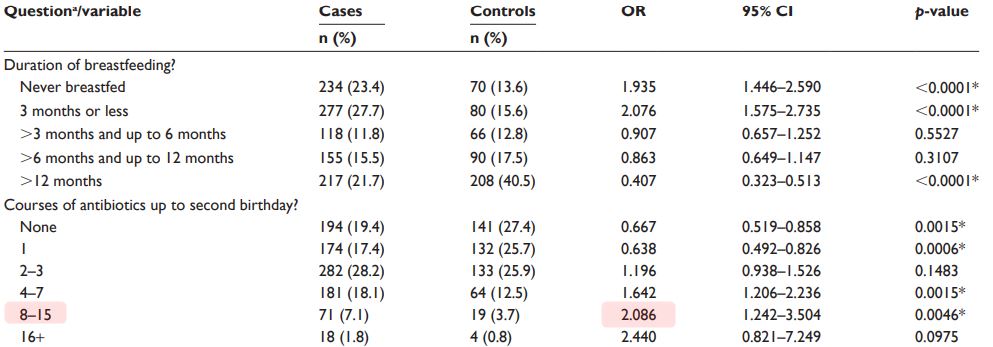Acetaminophen, antibiotics, ear infection, breastfeeding, vitamin D drops, and autism: an epidemiological study
Published 31 May 2018 Volume 2018:14 Pages 1399—1414. DOI https://doi.org/10.2147/NDT.S158811
Seth Scott Bittker,1 Kathleen Roberta Bell 2
1 Interdisciplinary Center for Innovative Theory and Empirics (INCITE), Columbia University, New York, NY, USA;
2 Independent Contractor, Waterloo, ON, Canada
Acetaminophen
*
📄 Known risks for taking Acetaminophen/Tylenol - PDF
* Report by
Perplexity AI - Deep Research April 2025 no mention asthma, ADHD
*
Acetaminophen (Tylenol) increases asthma
* Hypothesis: Acetaminophen reduces vitamin D, which increases asthma
*
Tylenol associated with both low vitamin D and Autism
*
ADHD 2 X more likely if Tylenol used a lot during pregnancy (Autism increased too) – Dec 2016
ADHD 3 X more likely if dark skinned mother had taken acetaminophen in 2nd trimester - Feb 2025
Associations of maternal blood biomarkers of prenatal APAP exposure with placental gene expression and child attention deficit hyperactivity disorder
Nature Mental Health volume 3, pages318–331 (2025) https://doi.org/10.1038/s44220-025-00387-6 PDF behind paywall
Brennan H. Baker, Theo K. Bammler, Emily S. Barrett, Nicole R. Bush, Brent R. Collett, Karen J. Derefinko, Daniel A. Enquobahrie, Catherine J. Karr, Kaja Z. LeWinn, Jiawang Liu, Christine T. Loftus, James W. MacDonald, Shanna H. Swan, Qi Zhao, Alison G. Paquette & Sheela Sathyanarayana
Despite evidence linking prenatal acetaminophen (APAP) exposure and adverse neurodevelopment in humans and animals, over half of pregnant women in most populations use APAP. Prior studies could be biased by inaccurate self-reported APAP use, and the molecular mechanisms linking prenatal APAP with adverse neurodevelopment are unknown. Here we estimated associations between maternal plasma biomarkers of APAP exposure, child attention deficit hyperactivity disorder (ADHD) and placental gene expression in 307 African American mother–child pairs.
Overall, detection of APAP in second trimester plasma was associated with higher odds for child ADHD diagnosis (
odds ratio of 3.15 (95% confidence interval 1.20 to 8.29)). Prenatal APAP exposure and ADHD were associated with placental upregulation of immune system pathways in females and downregulation of oxidative phosphorylation in both sexes. In females only, prenatal APAP was associated with 5.22% higher odds (0.0456–13.1%) of ADHD statistically, mediated through increased immunoglobulin heavy constant gamma 1 (IGHG1) expression. These results highlight placental molecular mechanisms that may underlie developmental toxicity of prenatal APAP exposure.
Antibiotics
*
Autism associated with low gut flora (due to antibiotics) – Mercola Oct 2014
*
Antibiotic increased risk of diabetes (Vitamin D might help) - several studies
*
Antibiotics, even short-term, cause long-term microbiome and metabolic changes in mice – June 2015
*
Antibiotic usage US map is very similar to obesity US map - June 2015
Antibiotics and Vitamin D are associated with many of the same diseases contains the following
{include}
📄 Download the PDF from VitaminDWiki



Background: While many studies have examined environmental risk factors for autism spectrum disorder (ASD), much of the research focus has been on prenatal or perinatal factors. Yet, the postnatal environment may affect the risk of ASD as well.
Objective: To determine whether a set of five postnatal variables are associated with ASD. These variables are: acetaminophen exposure, antibiotic exposure, incidence of ear infection, decreased duration of breastfeeding, and decreased consumption of oral vitamin D drops.
Materials and methods: An Internet-based survey was conducted. Participants were parents living in the USA with at least one biological child between 3 and 12 years of age. Potential participants were informed about the survey via postings on social media, websites, and listservs and were offered an opportunity to participate in a raffle as well. Participants were also recruited through the Interactive Autism Network.
Results: There were 1,741 completed survey responses. After exclusions, there remained 1,001 responses associated with children with ASD (cases) and 514 responses associated with children who do not have ASD (controls). In this data set, doses of postnatal acetaminophen (adjusted odds ratio [aOR] 1.016, CI: 1.003–1.032, p=0.026), courses of postnatal antibiotics (aOR 1.103, CI: 1.046–1.168, p<0.001), incidence of postnatal ear infection (aOR 1.137, CI: 1.046–1.236, p=0.003), and decreased duration of breastfeeding (aOR 0.948, CI: 0.932–0.965, p<0.001) are all associated with ASD when adjusted for eight demographic variables. A weak association between oral vitamin D drop exposure and ASD was also found when adjusted for breastfeeding and demographics (aOR 1.025, CI: 0.995–1.056, p=0.102).
Conclusion: This study adds to evidence that postnatal acetaminophen use, postnatal antibiotic use, incidence of ear infection, and early weaning are associated with an increased risk of ASD. It also finds that postnatal oral vitamin D drops are weakly associated with ASD when adjusted for breastfeeding and demographics.



